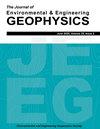基于多变量改进的基于教学的优化(MM-TLBO)算法的简单几何形状残余重力异常反演建模
IF 0.7
4区 工程技术
Q4 ENGINEERING, GEOLOGICAL
引用次数: 2
摘要
本文提出了一种改进的基于自然的算法,即多变量修正教学学习优化算法(MM-TLBO),该算法可以在迭代过程中估计多目标问题中模型参数的最优值。该算法分为两个计算阶段:教师阶段和学习者阶段。MM-TLBO算法的主要目的是提高学习器的值,从而提高模型参数的值,从而得到最优解。每个学习器(模型)的变量是半径(R)、深度(h)、形状因子(q)、密度对比(ρ)和轴位置(x0)参数。采用MM-TLBO和TLBO方法对球体、水平和垂直圆柱体等简单几何结构的埋藏体残余重力异常进行了分析。通过噪声损坏合成数据验证了这些方法的有效性,得到了可接受的结果。结果表明,MM-TLBO算法的性能优于TLBO算法。利用MM-TLBO对伊朗、美国、瑞典和塞内加尔6个地区的重力残余异常剖面进行了解释。MM-TLBO反演的优点是可以非常快速地估计出最优解,而不会陷入局部最小值而达到过早收敛。考虑的合成和真实重力数据的主要人口是30和50个模型。结果表明,即使在考虑少量学习者的情况下,该方法也能获得最优的响应。本文章由计算机程序翻译,如有差异,请以英文原文为准。
Multivariable Modified Teaching Learning Based Optimization (MM-TLBO) Algorithm for Inverse Modeling of Residual Gravity Anomaly Generated by Simple Geometric Shapes
This paper presents an improved nature-based algorithm, namely multivariable modified teaching learning based optimization (MM-TLBO) algorithm, as in an iterative process can estimates the best values for the model parameters in a multi-objective problem. The algorithm works in two computational phases: the teacher phase and the learner phase. The major purpose of the MM-TLBO algorithm is to improve the value of the learners and thus, improving the value of the model parameters which leads to the optimal solution. The variables of each learner (model) are the radius ( R), depth ( h), shape factor ( q), density contrast ( ρ) and axis location ( x0) parameters. We apply MM-TLBO and TLBO methods for the residual gravity anomalies caused by the buried masses with a simple geometry such as spheres, horizontal and vertical cylinders. The efficiency of these methods are also tested by noise corruption synthetic data, as the acceptable results were obtained. The obtained results indicate the better performance the MM-TLBO algorithm than the TLBO algorithm. We have utilized the MM-TLBO for the interpretation of the six residual gravity anomaly profiles from Iran, USA, Sweden and Senegal. The advantage of the MM-TLBO inversion is that it can estimates the best solutions very fast without falling into local minimum and reaches to a premature convergence. The considered primary population for the synthetic and real gravity data are thirty and fifty models. The results show which this method is able to achieve the optimal responses even if a small population of learners had been considered.
求助全文
通过发布文献求助,成功后即可免费获取论文全文。
去求助
来源期刊

Journal of Environmental and Engineering Geophysics
地学-地球化学与地球物理
CiteScore
2.70
自引率
0.00%
发文量
13
审稿时长
6 months
期刊介绍:
The JEEG (ISSN 1083-1363) is the peer-reviewed journal of the Environmental and Engineering Geophysical Society (EEGS). JEEG welcomes manuscripts on new developments in near-surface geophysics applied to environmental, engineering, and mining issues, as well as novel near-surface geophysics case histories and descriptions of new hardware aimed at the near-surface geophysics community.
 求助内容:
求助内容: 应助结果提醒方式:
应助结果提醒方式:


